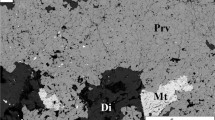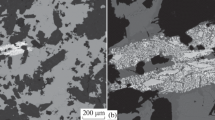Abstract
Pyrophanite in serpentinite at Perkupa (Hungary) is described in detail for the first time as a replacement product of perovskite. It occurs as a 20- to 30-μm-wide rim, mantling a remnant core composed of perovskite or its alteration products. The pyrophanite rim consists of an inner zone, representing a pseudomorph after perovskite, and an outer overgrowth zone. Raman mapping and electron backscatter diffraction data show that the pyrophanite rims typically represent single crystals rather than being composed of multiple domains in different crystallographic orientations. Perovskite occurs exclusively in the core of pyrophanite and was identified as the orthorhombic CaTiO3 phase, based on Raman spectra. Heterogeneous, polyphase mineral cores, consisting of calcite, anatase and/or brookite, kassite, and Mn-bearing kassite, in some cases in association with relict perovskite, are typical in the larger pyrophanite-rimmed grains. The crystallographically coherent pyrophanite rims could have formed through a process where the precursor perovskite crystal acted as a structural template for the newly forming phase, that is, by interface-coupled dissolution reprecipitation during serpentinization of the precursor rock. This alteration of perovskite to pyrophanite was not complete, resulting in the presence of perovskite fragments enclosed in pyrophanite. During the metamorphic evolution of the rock, some of the remnant perovskite cores further altered to TiO2 polymorphs (anatase and brookite) and calcite, via transitional alteration products.









Similar content being viewed by others
References
Árkai P, Kovács S (1986) Diagenesis and regional metamorphism of the Mesozoic of Aggtelek–Rudabánya Mountains (Northeast Hungary). Acta Geol Hung 29:349–373
Brousse R, Maury RC (1976) Paragenèse manganésifère d’une rhyolite hyperalcaline du Mont-Dore. Bull Soc Franç Miner Cristallogr 99:300–303
Chakhmouradian AR, Mitchell RH (2000) Occurrence, alteration patterns and compositional variation of perovskite in kimberlites. Can Mineral 38:975–994
Craig JR, Sandhaus DJ, Guy RE (1985) Pyrophanite MnTiO3 from Sterling Hill, New Jersey. Can Mineral 23:491–494
Crerar DA, Cormick RK, Barnes HL (1980) Geochemistry of manganese: an overview. In: Varentsov IM, Grasselly Gy (eds) Geology and geochemistry of manganese (vol 1. General problems: mineralogy, geochemistry, methods). Akadémiai Kiadó, Budapest, pp 293–334
Dasgupta S, Fukuoka M, Roy S (1984) Hematite-pyrophanite intergowth in gondite, Chikla area, Sausar Group, India. Mineral Mag 48:558–560
Galuskin E, Galuskina I, Dzierżanowski P (2004) New natural phase MnTi2O4(OH)2 × H2O(?) with uncertain structure–indicator of sea floor metasomatism. Mineral Soc Pol 24:157–160 (special papers)
Gaspar JC, Wyllie PJ (1983) Ilmenite (high Mg, Mn, Nb) in the carbonatites from the Jacupiranga Complex, Brazil. Am Mineral 68:960–971
Gillet P, Guyot F, Price GD, Tournerie B, Le Cleach A (1993) Phase changes and thermodynamic properties of CaTiO3. Spectroscopic data, vibrational modeling and some insights on the properties of MgSiO3 perovskite. Phys Chem Miner 20:159–170
Glikin AE (2008) Polymineral-metasomatic crystallogenesis. Springer, Netherlands 314 p
Glikin AE, Sinai MY (1983) Experimental investigation of monocrystal pseudomorph formation. Zapiski VMO 6:742–748
Grey IE, Mumme WG, Pekov IV, Pushcharovsky DYu (2003) The crystal structure of chromian kassite from the Saranovskoye deposit, Northern Urals, Russia. Am Mineral 88:1331–1335
Hamberg A (1890) Mineralogische Studien. Geol Fören Förhandl 12:567–637
Harangi Sz, Szabó Cs, Józsa S, Szoldán Zs, Árva-Sós E, Balla M, Kubovics I (1996) Mesozoic igneous suites in Hungary: implications for genesis and tectonic setting in the Northwestern Part of Tethys. Int Geol Rev 38:336–360
Hariya Y (1980) On the geochemistry and formation of manganese dioxide deposits. In: Varentsov IM, Grasselly Gy (eds) Geology and geochemistry of manganese (vol 1. General problems: mineralogy, geochemistry, methods). Akadémiai Kiadó, Budapest, pp 353–365
Hem JD (1972) Chemical factors that influence the availability of iron and manganese in aqueous systems. Geol Soc Am Bull 83:443–450
Holland TJB, Redfern SAT (1997) Unit cell refinement from powder diffraction data: the use of regression diagnostics. Mineral Mag 61:65–77
Horváth P (1997) High-pressure metamorphism and P-T path of the metabasic rocks in the borehole Komjáti-11, Bódva Valley area, NE Hungary. Acta Min Pet Szeged 38:151–163
Horváth P (2000) Metamorphic evolution of gabbroic rocks of the Bódva Valley Ophiolite Complex, NE Hungary. Geol Carp 51:121–129
Horváth P, Árkai P (2005) Amphibolite-bearing assemblages as indicators of microdomain-scale equilibrium conditions in metabasites: an example from Alpine ophiolites of the Meliata Unit, NE Hungary. Mineral Petrol 84:233–258
Ivan P (2002) Relics of the Meliata ocean crust: geodynamic implications of mineralogical, petrological and geochemical proxies. Geol Carp 53:245–256
Kovács S (1984) North Hungarian Triassic facies types. Acta Geol Hung 27:251–264
Kovács S, Less Gy, Piros O, Réti Zs, Róth L (1989) Triassic formations of the Aggtelek-Rudabánya Mountains (NE Hungary). Acta Geol Hung 32:31–63
Krot AN, Rubin AE, Kononkova NN (1993) First occurrence of pyrophanite (MnTiO3) and baddeleyite (ZrO2) in an ordinary chondrite. Meteoritics 28:232–239
Lee DE (1955) Occurrence of pyrophanite in Japan. Am Mineral 40:32–40
Less Gy (2000) Polyphase evolution of the structure of the Aggtelek-Rudabánya Mountains (NE Hungary); the southernmost element of the Inner Western Carpathians: a review. Slovak Geol Mag 6:260–268
Less Gy, Kovács S, Szentpétery I (eds), Grill J, Róth L, Gyuricza Gy, Sásdi L, Piros O, Réti Zs, Elsholz L, Árkai P, Nagy E, Borka Zs, Harnos J, Zelenka T (2006) The geology of the Aggtelek-Rudabánya mountains (Map series of the Hungarian regions) (in Hungarian with English summaries): Az Aggtelek-Rudabányai-hegység földtana (Magyarország tájegységei térképsorozata). MÁFI, Budapest, pp 1–92
Liferovich RP, Mitchell RH (2006) The pyrophanite-geikielite solid-solution: crystal structures of the Mn1–XMgXTiO3 series (0 < x < 0.7). Can Mineral 44:1099–1107
Liipo JP, Vuollo JI, Nykänen VM, Piirainen TA (1994) Pyrophanite and ilmenite in serpentinized wehrlite from Ensilä, Kuhmo greenstone belt, Finland. Eur J Mineral 6:145–150
Lindh A, Malmstrom L (1984) The occurrence and formation of pyrophanite in late-formed magnetite porphyroblasts. Neues Jahrb Mineral Monats 13–21
Mikhailova YA, Konopleva NG, Yakovenchuk VN, Ivanyuk GY, Men’shikov YP, Pakhomovsky YA (2007) Corundum-group minerals in rocks of the Khibiny alkaline pluton, Kola Peninsula. Geol Ore Dep 49:590–598
Mitchell RH (2002) Perovskites: modern and ancient. Almaz Press, Thunder Bay 318 p
Mitchell RH, Chakhmouradian AR (1998) Instability of perovskite in a CO2-rich environment: examples from carbonatite and kimberlite. Can Mineral 36:939–951
Mitchell RH, Liferovich RP (2004) Zincian pyrophanite-ecandrewsite solid-solution series and associated minerals from lujavrite, Pilansberg alkaline complex, South Africa. Can Mineral 42:1169–1178
Mücke A, Woakes M (1986) Pyrophanite: a typical mineral in the Pan-African province of western and central Nigeria. J Afr Earth Sci 5:675–689
Nayak BR, Mohapatra BK (1998) Two morphologies of pyrophanite in Mn-rich assemblages, Gangpur Group, India. Mineral Mag 62:847–856
Nemecz E (1956) The investigation of the serpentinite from Perkupa. In Hungarian: A perkupai szerpentin vizsgálata. Földt Közl 86:424–434
Portnov AM (1965) Pyrophanite from northern Baikalia. Dokl Acad Sci USSR Earth Sci Sect 153:126–138
Putiš M, Koppa M, Snárska B, Koller F, Uher P (2012) The blueschist-associated perovskite-andradite-bearing serpentinized harzburgite from Dobšiná (the Meliata Unit), Slovakia. J Geosci 57:221–240
Putnis A (2002) Mineral replacement reactions: from macroscopic observations to microscopic mechanisms. Mineral Mag 66:689–708
Putnis CV, Mezger K (2004) A mechanism of mineral replacement: isotope tracing in the model system KCl-KBr-H2O. Geochim Cosmochim Acta 68:2839–2848
Putnis A, Putnis CV (2007) The mechanism of reequilibration of solids in the presence of a fluid phase. J Solid State Chem 180:1783–1786
Radvanec M (2009) P–T path of perovskite-clinopyroxene-grossular bearing fragments enclosed in meta-peridotite (Dankova, Gemer area, Western Carpathians). 8th international eclogite conference, Xining, China, Abstracts, pp 121–122
Réti Zs (1985) Triassic ophiolite fragments in evaporitic melange, Northern Hungary. Ofioliti 10:411–422
Réti Zs (1987) Comparison between Mesozoic mafic and ultramafic complexes in Northern Hungary. Ofioliti 12:43–52
Sasaki K, Nakashima K, Kanisawa S (2003) Pyrophanite and high Mn ilmenite discovered in the Cretaceous Tono pluton, NE Japan. Neues Jahrb Mineral Monats 2003:302–320. http://dx.doi.org/10.1127/0028-3649/2003/2003-0302
Suwa K, Enani M, Hiraiwa I, Yang T (1987) Zn-Mn ilmenite in the Kuiqi granite from Fuzhou, Fujian province, East China. Mineral Petrol 36:111–120
Tsusue A (1973) The distribution of manganese and iron between ilmenite and granitic magma in the Osumi Peninsula, Japan. Mineral Petrol 40:305–314
Ulrych J, Lang M (1985) Accessory pyrophanite in granite and manganojacobsite in dioritic amphibolite from the Manicaragua Zone, central Cuba. Chem Erde 44:273–280
Veilla N, Jiménez-Millán J (2003) Origin and metamorphic evolution of rocks with pyrophanite from the Iberian Massif (SW Spain). Mineral Petrol 78:73–91
Wedepohl KH (1980) Geochemical behavior of manganese. In: Varentsov IM, Grasselly Gy (eds) Geology and geochemistry of manganese (vol 1. General problems: mineralogy, geochemistry, methods). Akadémiai Kiadó, Budapest, pp 335–351
Zaccarini F, Garuti G, Ortiz-Suarez A, Carugno-Duran A (2004) The paragenesis of pyrophanite from Sierra de Comechingones, Córdoba, Argentina. Can Mineral 42:155–168
Žák L (1971) Pyrophanite from Chvaletice (Bohemia). Mineral Mag 38:312–316
Železný V, Cockayne E, Petzelt J, Limonov MF, Usvyat DE, Lemanov VV, Volkov AA (2002) Temperature dependence of infrared-active phonons in CaTiO3: a combined spectroscopic and first-principles study. Phys Rev B 66:224303
Acknowledgments
The European Union and the European Social Fund provided financial support for the project through grant agreements no. TÁMOP 4.2.1./B-09/KMR-2010-0003 (EBSD) and TÁMOP-4.2.1.B-10/2/KONV-2010-0001 within the framework of the New Hungary Development Plan. The Raman microscope at the Eötvös University was purchased through funding by the Baross Gábor Programme (REG-KM-09-1-2009-0044). We also acknowledge the help of the Department of Mineral Sciences, Smithsonian National Museum of Natural History, Washington, USA, for providing standards used in the WDX measurements. We would like to thank Guest Editor Anton R. Chakhmouradian, who encouraged us during this work and also gave useful ideas for the preparation of the manuscript. We are also thankful to Evgeny A. Galuskin and Victor V. Sharygin, whose detailed comments and corrections helped improve this paper.
Author information
Authors and Affiliations
Corresponding author
Rights and permissions
About this article
Cite this article
Zajzon, N., Váczi, T., Fehér, B. et al. Pyrophanite pseudomorphs after perovskite in Perkupa serpentinites (Hungary): a microtextural study and geological implications. Phys Chem Minerals 40, 611–623 (2013). https://doi.org/10.1007/s00269-013-0596-2
Received:
Accepted:
Published:
Issue Date:
DOI: https://doi.org/10.1007/s00269-013-0596-2




